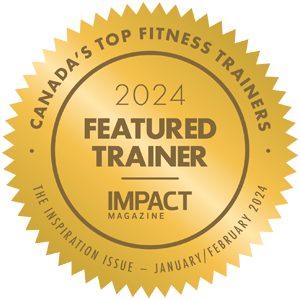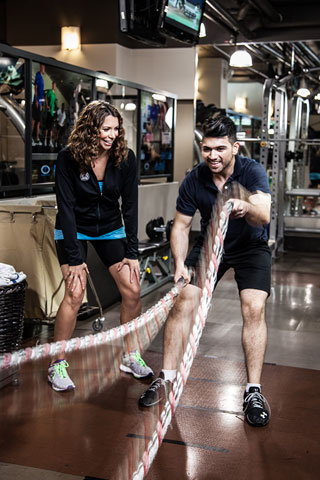I don't know anyone who doesn't want a flatter, stronger midsection, a six pack, or for those boys who wear their pants way too low, an eight pack. For starters, six packs are made in the kitchen. That statement isn't entirely true. Abdominals are like any other muscle, and they respond to the demands you impose upon them. However, if your nutrition is not what it should be, all the strength and conditioning in the world is not going to get you where you want to be. This article is not about diet, it is about conditioning. So how do the pros train their cores?
Dr Stuart McGill is telling us that there is a finite number of times we can flex our spine before it will break down, leading to injury. This must also hold true for the other joints in our bodies, but since the spine protects the essential spinal cord, we should err on the side of caution. If we don't want to waste that valuable flexion in the gym performing endless numbers of crunches, what do we do to train the abdominals? Well we could perform McGill's spine friendly version of the crunch, by placing our hands under our low back, extending one leg, flexing the other leg with the foot placed firmly on the ground, pretending our head and shoulders are resting on a scale and making the scale read zero by activating our core. This is a perfect exercise for individuals who have compromised backs, but what about athletes and those boys with the too low pants; they want to be challenged in numerous ways. So let's talk about rotation, anti-rotation, and anti-extension exercises.
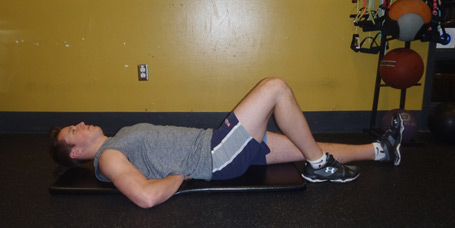
McGill's version of the crunch
Anti-Rotation
Anti-rotation exercises are great for increasing your ability to stiffen your core. Perhaps you have heard the phrase, proximal stiffening for distal mobility. What the heck does that mean? The most efficient movement strategy is to move from the centre out, proximal to distal. If your core is strong and you posses the ability to stiffen and maintain the integrity between your pelvis and shoulder complex, you will be able to produce and transfer energy more efficiently to your limbs, as well as protect your spine. It is easy to find examples of this in sport: quarter back, tennis player, MMA fighter, or you when you open a pickle jar.
There are a number of ways to perform anti-rotation exercises. As the name states the goal is to prevent rotation from occurring, or by creating dissociation between the pelvis and shoulder complex, allowing movement in one area and none in the other. To begin, look at anti-rotation exercises using a resistance tube or a pulley station.
- For the first exercise grasp the handle of your tube or cable with both hands. Hold it in front of your chest with your side facing the anchor of your tube or cable. Then clamp down on your abdominals, and while maintaining a neutral position side step out for 3 to 4 steps. Turn around and repeat. You should be able to maintain a stiff neutral spine position and resist the pull to the side that the resistance creates.
- Next, try standing away from the pulley with your side facing it. Bracing your abdominals, and again with both hands on the handle in the centre of your chest extend your arms out. At this point you have three choices: (a.) you may oscillate the handle from side to side, while maintaining a solid unmoving position with your pelvis, or (b.) you may push the handle away from your chest and pull back in towards your chest, keeping that stiff core, or (c.) you may lift and lower the handle. Again your core is braced hard and you are resisting the pull to the side.
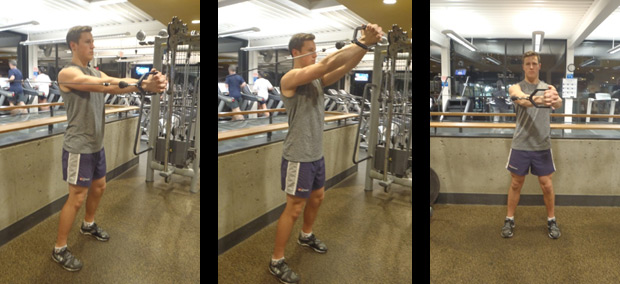
Anti-rotation, Lift & Oscillate
Let's head to the floor for anti-rotation from a plank position. Get into a push up position with a straight line from ear, through shoulder, hip, knee and ankle, but place your feet wider than shoulder width apart to increase stability. Create and maintain tension in your core. Now lift one hand placing it on your opposite shoulder, hold for 5 seconds. Perform 8 to 10 repetitions. Your shoulders should remain level and your hips square. Place that hand down and repeat with your other hand. If this is too easy, grab some dumbbells for a renegade row. With a dumbbell in each hand, hexagon for those of us with pretty teeth and noses, round if you are tough, assume your push up position, feet wide, core tight, and pull one dumbbell up, executing a row. Alternating left and right for a set of ten reps or so, again no rotation should occur, shoulders and hips stay level.
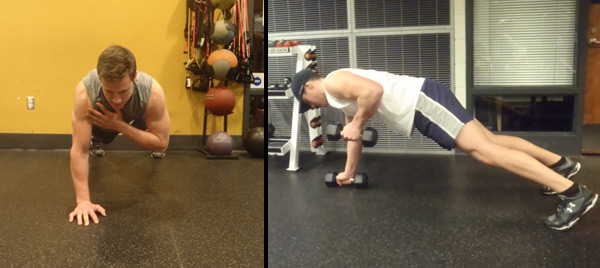
Anti-rotation Plank & Renegade Row
If you are lucky enough to have a landmine available, it provides some great options for anti-rotation and rotation exercises using a barbell. Otherwise jam the end of your barbell in a corner. A single arm press on the landmine can be an anti-rotation exercise, if you tighten up and keep your shoulders square, while you perform a strict press. Another example of a great landmine exercise is to face the landmine, both hands on the bar, brace your abdominals hard while moving the bar from side to side reaching as far as you can without rotating. The ability to stiffen through your core and maintain this tension will help to support and protect your spine while performing heavy lifts in the gym, as well as improving your ability to move with a proximal to distal strategy.
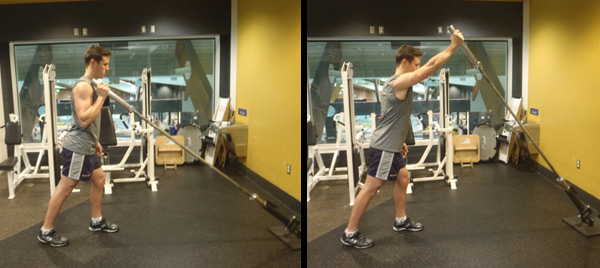
Shoulder Press
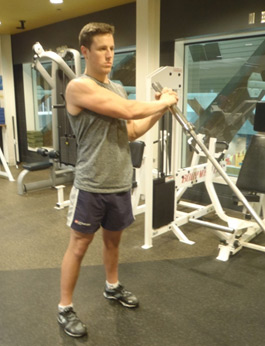
Disassociation with the Landmine
Rotation
Many sports require rotational power, from slap shots to home runs. When in the gym you should add exercises from the chop family into your routine. Two rotational options on the landmine are rainbows and combat rotations. For rainbows stand facing the landmine with feet wide apart, both hands on the bar, move the bar in a sweeping curve aka a rainbow, from side to side while pivoting on the balls of your feet. To perform a combat rotation stand to the side of the barbell, I like to lock out my arms and start with my hands on the bar next to my outside upper thigh. From this start position in an arc motion lift the bar up and across, allowing your hips to rotate with your shoulders and pivot on your outside foot.
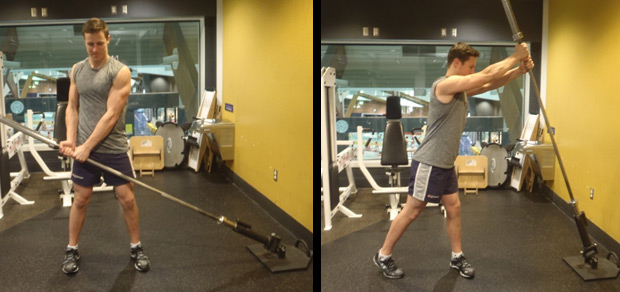
Combat Rotation
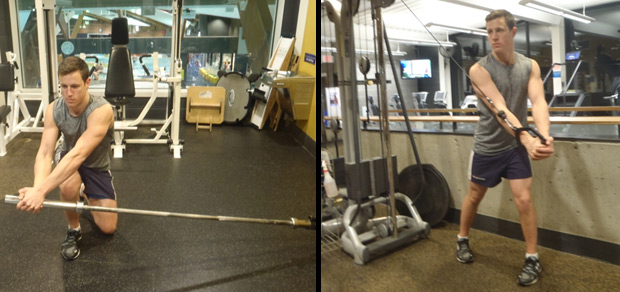
Rainbow & Woodchop
Chops can also be performed with plates, dumbbells, sandbags etc, but let's return to the pulley station. Once again there are several options: you can kneel, half kneel, stand, go from low to high, straight across, high to low etc. To perform your basic wood chop, set the pulley high, I like to use a rope handle or you can use the single handle, step away from the pulley and have your side facing towards it, at this point your arms are extended up to the side with both hands on the handle, now you are going to chop down and across, rotating as you maintain that stiff core and a big chest. With rotational exercises, you want to avoid rotation through your lumbar spine aka your low back as it is not designed to rotate. Another tip for joint friendly rotational exercises is to allow your hips to move and foot to pivot to avoid stress on your back and knees.
Anti-extension
Although the options for core conditioning are numerous with virtually endless variations, two highly effective exercises, and personal favourites of mine, are the roll out, and body saw combined with a pike. We can call these anti-extension exercises, as the goal is to prevent your spine from hyper-extending, it should remain neutral. I love to use the wheel to perform the roll out. You can make it easier by using a stability ball or harder by using a medicine ball, TRX, or perhaps a glider. Being a bit of a princess, I like to use the wheel from a kneeling position. If you are more hardcore than I am, standing is a lot more impressive. The secret to a good roll out and body saw is that ability to hold tension through your abdominals, keeping that rock solid connection between your shoulder complex and pelvis. For the wheel roll out, kneel with the wheel centered in front of you, grip the wheel firmly and roll forward. Your shoulders and hips should be moving at the same rate as you extend out. Keeping a very tight core and neutral spine is key to this move. Once you have extended your hands forward as far as you can you need to light those big lats up and pull the wheel back towards you.
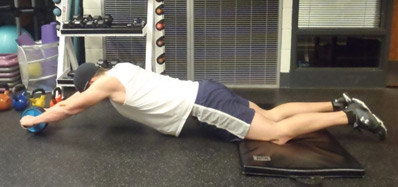
Rollout
The easiest ways to perform a body saw and pike, not to say it is easy, is to use a stability ball or a TRX. The same as in the roll out you need to be tight and solid through your core. Place your hands or elbows either on the floor or on a bench, with your feet either in the TRX or on a stability ball. From this position which is basically a plank you are going to move your body back away from your hands, increasing flexion at the shoulder. You can just rock it back and forth for a body saw, or you can rocket you butt up, for a pike. The pike is a fancy hip hinge, where you push your butt towards the ceiling as you pull your feet in, keeping your legs straight and that core lit up, ending in an elbow or handstand, and returning back down to a plank.
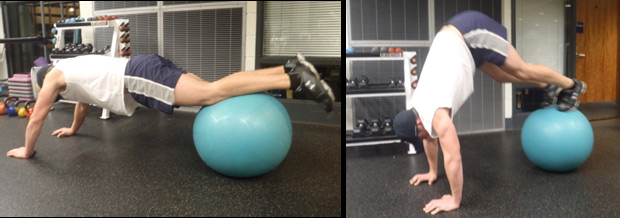
Bodysaw & Pike
So why have you only been doing crunches for your abs? Train like a pro, add anti-rotation, rotation and anti-extension exercises into your program for a rock hard core, stable back and a better ability to move proximal to distal.
Bookmark & ShareThe first time I came across the world of bar athletes, I was at work supervising the weight room about 5 years ago. One of the young guys said to me, "You have to see this!" He brought up a video on Youtube of the human flag by MarcusBondi , next was a video of Bartendaz. They were flying without wings! Then I watched a little video called Hannibal for King, maybe you have heard of it. It has been viewed over 8 million times. I was inspired! I was awestruck! I was amazed! And I was addicted!
Ever since that day I have felt compelled to share those videos with others, talk about how amazing they are, and of course keep watching.
So what is it about bar athletes that I find so mesmerizing? The obvious answer would be the demonstration of pure strength, power, control, and body awareness they exhibit. They are truly incredible athletes.
Perhaps the not so obvious answer is more along the lines of the philosophy behind it, and what I see as a grass roots movement. Giant the founder of Bartendaz in their videos talks about how "Health is wealth, and movement is medicine." He talks about developing character, developing your mind, as well as your body. He also speaks of taking back the parks, and bringing back the light.
I see this as being a way for people living in the inner cities, of low socio-economic status to take ownership over there health and well being. For them to rise up, and do something great for themselves, while inspiring others to do the same. It is not about how great you can become, it is about how many others you make great along with you.
In my quest to learn more about bar athletes and the sport, I was fortunate enough to ask Hit Richards the founder of the Calisthenics Kingz a few questions. Hit began training in calisthenics about 16 years ago, and formed the Calisthenics Kingz in 2007. There are now members around the world. The Calisthenics Kingz have spread to Mexico, New Zealand, Hungary, Serbia, Australia, Moscow, and the Czech Republic, and in the USA there are members in Los Angeles, Washington, Seattle, and New York City. So what does it take to cut it as a Calisthenics Kingz member, not only dedication and mental strength, but the ability to perform "5 strict form muscle-ups, 10 strict form pull-ups (with chin clearing the bar on all 10), 6 front levers (all without letting the bar go or touching the ground), then 30 second handstand hold, 20 dips (full range of motion) 20 basic push-ups, the whole routine is to be done in 3 minutes or less." Seems achievable with a little work, no?
Hit travelled this year to the Ukraine, Moscow and France to judge competitions. The sport of bar athletics is spreading. I was curious about the history of the sport and how it has evolved. Hit believes that the competitions started in the parks of New York. Videos began to be posted on YouTube, stimulating competitiveness as moves were analyzed and perfected. Being a new sport each competition is slightly different based on who is organizing it. Some of the competitions are only freestyle, some include freestyle and maximum repetitions (with perfect form of course), and some are only for maximum reps. Again it depends on the organizers if there are different weight classes or not. The freestyle competitions are judged based on creativity, excellent form when executing a move, and the strength level of the actual move. A score is developed based on those criteria.
The world of bar athletes and calisthenics encourages everyone to try it, and to believe you can achieve anything with a little focus and determination. Men, women, children and seniors are all involved in being active and working towards their goals. It naturally lends itself to a sense of community, and using parks for what they are meant for, people gathering and being active.
I asked Hit what his personal philosophy is and he had this to say, "My personal philosophy which also happens to be my mission statement as well behind bar athletics is: Follow a 4 D system, DRIVE, DEDICATION, DISCIPLINE & DETERMINATION. This system can be applied to any aspect of your life."
I asked Hit what his personal philosophy is and he had this to say, "My personal philosophy which also happens to be my mission statement as well behind bar athletics is: Follow a 4 D system, DRIVE, DEDICATION, DISCIPLINE & DETERMINATION. This system can be applied to any aspect of your life."
Of course no interview of a bar athlete is complete without asking about his favourite move. Hit says, "My favorite move is one of my own creation, Handstand push-ups on TOP of the bar, it is my favorite move because it takes a lot of balance and strength but most importantly mental focus when performing this move, because you must maintain strict form, when balancing and full range of motion while doing push-ups so high up in the air. The hardest part is maintaining the balance while you're doing the push-ups."
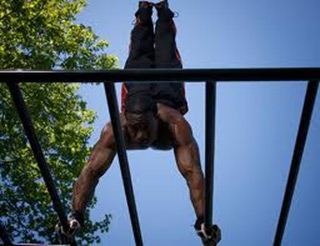
Hit Richards
The sport of bar athletics and basic calisthenics workouts are spreading around the world. The evidence for this is seen not only in Hit Richards trips to other countries to judge competitions, or members of the Calisthenics Kingz being around the world, it is also seen in the commercialization of bar athletics. In 2010 Juan Carlos Santana from IHP travelled to New York to train with Bartendaz and film the JC Giant Project DVDs. Also, Bartendaz appeared on an episode of The Doctors in 2009 as positive role models for urban youth. I am obviously not alone in thinking this sport and the athletes in it inspire, motivate, and have the ability to spark change in the lives of the people they reach. This sport will continue to grow and spread its reach from the urban parks in which it was born to anywhere in the world in which someone says, I can do that!
Hit - http://www.youtube.com/watch?v=zdhMxnK8xXQ
MarcusBondi - http://www.youtube.com/watch?v=2g19Q65g_3c
Bartendaz - http://www.youtube.com/watch?v=SWs94Pu_kG4
Hannibal - http://www.youtube.com/watch?v=pfsTKfUT-RQ
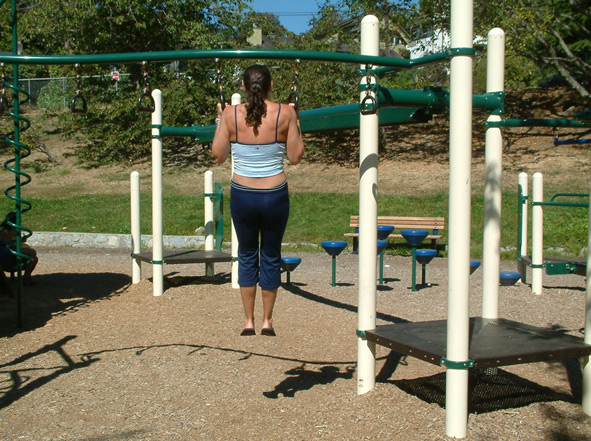
(photo of the author)
Bookmark & Share